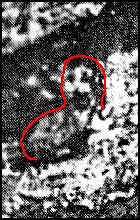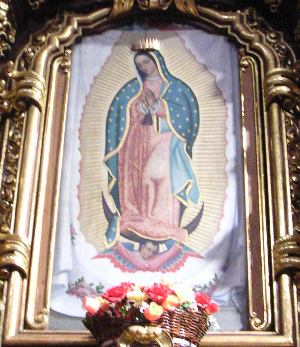Our Lady of Guadalupe
|
|
Virgen_de_guadalupe.jpg
Our Lady of Guadalupe is the title given to the Virgin Mary after appearing, according to legend, to Saint Juan Diego Cuauhtlatoatzin, an Aztec convert to Catholicism, in the village of Guadalupe (the present-day Gustavo A. Madero, D.F.) near Mexico City in 1531.
Less famously, the same name also refers to a statue of Mary that dating from 1326, found in the city of Guadalupe in Spain.
| Contents |
Origin of the Mexican Lady of Guadalupe
According to the story generally accepted by Catholics, Juan Diego was walking between his village and Tenochtitlan (now Mexico City), where the Catholic mission was headquartered, on December 12, 1531. Along the way, in the village of Guadalupe, the Virgin Mary appeared, speaking to him in his native Nahuatl language. She told him to build a church at the site, but when Juan Diego spoke to the Spanish bishop, the bishop did not believe him, asking for a miraculous sign. The Virgin told Juan Diego to gather flowers from a hill, even though it was winter, when no plants bloom. He found Spanish roses and presented these to the bishop. When the roses fell from his tilma (a kind of apron) an icon of the Virgin remained imprinted on the cloth.
The Basilica
Two basilicas bear the name of Our Lady of Guadalupe: the first, begun in 1531, and the current one, built between 1974 and 1976 by the Mexican architect Pedro Ramírez Vásquez. It is a circular building constructed in such a way as to allow maximum visibility for the image to those inside. The older one has been closed for many years pending repair; the basilica is sinking as a result of the weakness of the ground, as the city was built on a former lake.
The image
The apron Juan Diego Cuauhtlatoatzin wore was studied by Philip Serna Callahan in 1981 (The Tilma under Infra-red Radiation) with infrared rays. He reported that the portions of the face, hands, robe, and mantle had been painted in one step, with no sketches or corrections and no paintbrush strokes. The Nobel Chemistry prize recipient Richard Kuhn said in 1936 that the colouring was not from a mineral, vegetable, or animal source. Studies started in 1956 and continuing to the present by several ophthalmologists, including Dr. Javier Torroella Bueno (1956) and Dr. José Aste Tonsmann (El Secreto de sus Ojos, 2001), claim to have found images reflected in the eyes of the Virgin after amplifying the photographs to 2500x magnification. The pupils reflect a group of Native Americans and Franciscans. Some experts from the textile industry said they cannot understand how the image of Our Lady of Guadalupe has been conserved since 1531, exposed to dust, heat, and humidity, without wearing down, and without discoloration. On November 14, 1921, a factory worker placed a bomb a few feet away from the apron. The explosion demolished the marble steps of the main altar, the windows of nearby homes and it bent a brass crucifix, but the fabric suffered no damage. Since 1993, the apron has been protected by bullet-proof glass in the Basilica of Guadalupe in Mexico City.
Other studies dispute these assertions. The claim of a supernatural painter is challenged by a formal investigation of the apron conducted in 1556, in which it was stated that the image was "painted yesteryear by an Indian", specifically "the Indian painter Marcos". This may have been the Aztec painter Marcos Cipac de Aquino, who was active in Mexico at the time the Image of Guadalupe appeared. Disputing the claims that the paint used on the apron could not be identified, the Spanish-language magazine Proceso (2002) reported the work of the art restoration expert José Sol Rosales. He examined the cloth with a stereomicroscope and identified calcium sulphate, pine soot, white, blue, and green "tierras" (earths), reds made from carmine and other pigments, as well as gold. All in all he found the work consistent with 16th century materials and methods. Joe Nickell and John F. Fischer, reporting in Skeptical Inquirer in 1985, found that the images seen in the Virgin's eyes may be the result of the human imagination's ability to form familiar shapes from random patterns, much like a psychologist's inkblots, a phenomenon known as pareidolia.
Origin of the Name
The origin of the name "Guadalupe," in the American context, is something of a mystery. According to a report at the time, the Virgin identified herself that way in a later apparition to Juan Diego's uncle. Those who doubt the story of Juan Diego and the apparitions argue that the 1533 church was dedicated to the Spanish Our Lady of Guadalupe (see above), with the American version developing later. Others have suggested that the name is a corruption of a Nahuatl name "Coatlaxopeuh", which has been translated as "Who Crushes the Serpent". In this interpretation, the serpent referred to is Quetzalcoatl, one of the chief Aztec gods, whom the Virgin Mary "crushed" by inspiring the conversion of the natives to Catholicism. This explanation has been adopted by some who hold that the motive of the Catholic Church in the Americas was to harshly wipe out native beliefs.
Popularity of the Virgin of Guadalupe
Our_Lady_of_Guadalupe--graffiti_in_East_Los_Angeles.JPG
Despite disputes as to the veracity of claims about the image, the Virgin of Guadalupe has proved very popular in Mexico over the years. A church was built in 1533, dedicated to Our Lady of Guadalupe. Thereafter, Spanish missionaries used the story of her appearance to help convert millions of indigenous people in what had been the Aztec Empire. Our Lady of Guadalupe still underpins the faith of Catholics in Mexico and the rest of Latin America, and she has been recognised as patron saint of Mexico City since 1737, with her patronage extended piece by piece until it included all of America by 1946. Much of the recent increase in Marianism in the Catholic Church, including the call to recognise Mary as co-redemptrix, stems from the cult of Guadalupe. Today many make the pilgrimage to the Basilica of Guadalupe, on the Cerro of Tepeyac, some crawling on their knees for kilometres, or even from their homelands in other cities, or even states, to pray to the Virgin of Guadalupe. It is said that she can cure almost any sickness. Also, many problem drinkers, instead of going to Alcoholics Anonymous or similar programmes, go there to promise her that they will never drink again, or abstain for a certain period; it is reported that the majority of these find the strength to fulfill their promise. That can illustrate how much love Mexicans pay to their Virgencita, the affectionate diminutive by which she is called.
The apron containing her image has been hung in the church built on the spot through the building's various versions, including today's Basilica of Guadalupe. The picture is of a woman with olive skin, rather than the white skin of European iconography, that appealed to both indigenous Mexicans and their mestizo descendants as one of them. Similarly, the man that she is supposed to have appeared to, Juan Diego, was an Indian, not a European Spaniard. The image of Our Lady of Guadalupe has been used by advocates of indigenous rights throughout Mexico's history, most recently by the Zapatista movement.
Replicas can be found in thousands of churches throughout the world, including Notre Dame Cathedral in Paris, and numerous parishes bear her name. Devotion to Our Lady of Guadalupe today is widespread among Catholics in every part of the globe.
María Guadalupe or just Lupe is a frequent female name in the Spanish language.
External links
- Official website (in Spanish) (http://www.virgendeguadalupe.org.mx/)
- A Catholic site dedicated to Our Lady of Guadalupe (http://www.sancta.org/)
- 12 December festivities (http://news.bbc.co.uk/2/hi/uk_news/in_pictures/3321581.stm) in San Miguel de Allende, Gto. (BBC photo essay)es:Virgen de Guadalupe
nl:Onze lieve vrouw van Guadalupe pt:Nossa Senhora de Guadalupe


